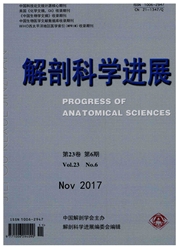

 中文摘要:
中文摘要:
目的 研究锌转运体7(ZnT7)和游离锌离子在小鼠脊髓室管膜和脉络丛上皮细胞中的分布.方法 应用ZnSe金属自显影技术(AMG)检测硒酸钠注射1.5h后小鼠脊髓室管膜细胞及脑室脉络丛上皮细胞的游离锌离子;应用免疫组织化学SABC法检测小鼠脊髓室管膜细胞及脑室脉络丛上皮细胞中ZnT7的表达.结果 光镜下观察AMG染色的切片,小鼠脊髓室管膜细胞及脑室脉络丛上皮细胞中均有游离锌离子的分布;免疫组织化学结果表明,脊髓室管膜细胞及脉络丛上皮细胞中均有ZnT7的表达,且与游离锌离子分布区域基本一致.结论 锌离子可能在脊髓室管膜细胞及脉络丛上皮细胞内发挥重要作用,脊髓室管膜细胞及脉络丛上皮细胞可能在脑脊液锌转运过程中发挥重要的作用.
 英文摘要:
英文摘要:
Objective To investigate the localization of zinc transporter 7 (ZnT7) protein and free zinc ions in ependyma cells in mouse spinal cord and choroid plexus cells in mouse brain. Methods Zinc selenide autometallography (AMG) was used to detect free zinc ions in mouse ependyma and choroid plexus 1.5 hours after sodium selenite treatment; SABC immunohistochemistry was used to detect the location of ZnT7 protein in ependyma and ehoroid epithelium. Results One and half hours after selenite intraporitoneal injection, almost all epondyma and choroid plexus cells showed AMG positive reactivity. ZnT7-immunoreaetive cells were observed in almost all ependyma cells and choroid plexus cells, and the distribution of the immunoreactivity was similar to the AMG staining. Conclusion The abundant distribution of both ZnT7 protein and free zinc ions in mouse epondyma and choroid plexus cells sugtrusts that zinc may nlav a important role in eDendvma and choroid plexus.
 同期刊论文项目
同期刊论文项目
 同项目期刊论文
同项目期刊论文
 期刊信息
期刊信息
